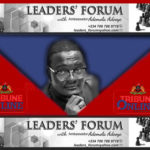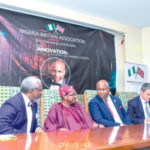Towards the end of his administration, former President Olusegun Obasanjo mooted the idea of Vision 2020, an aspiration to grow the economy such that “By 2020 Nigeria will be one of the 20 largest economies in the world, able to consolidate its leadership role in Africa and establish itself as a significant player in the global economic and political arena.” With that vision, the leadership of the country hoped to put Nigeria in the class of leading economies such as the United States of America, Japan, Germany, China, France, the United Kingdom, Brazil, India, South Korea and Indonesia.
Although former President Umaru Musa Yar’Adua, who succeeded Obasanjo in 2007, came up with his own Seven-Point Agenda, he still believed in Vision2020 and, in August 2008, set up the National Council on Vision2020 to provide leadership and direction to achieve the vision by using a bottom-up approach which would ensure ownership by all stakeholders. The government also set up committees such as the National Steering Committee on Vision2020, the Stakeholder Development Committee, and the National Technical Working Groups Committee to carry out various functions. After the demise of President Yar’Adua in 2010, the administration of President Goodluck Jonathan continued with the pursuit of the vision. But now in November 2019, eve of the target year, not only is Nigeria’s economy nowhere near being ranked among the leading 20 economies in the world, no one is even talking about the vision anymore. Nigeria’s economy is bogged down by slow growth and rising unemployment, which have effectively combined to push almost a half of the population into extreme poverty.
Why did Vision2020, as desirable as it was, die? Why did Nigeria fail to make the transition into the league of leading economies?
On May 25, 1961, former president of the United States of America, John F. Kennedy, proposed to the Congress that the United States “should commit itself to achieving the goal, before this decade is out, of landing a man on the moon and returning him safely to the Earth.”
Although President Kennedy was assassinated on November 22, 1963, the vision of landing a man on the moon within a decade was realized because on July 20, 1969, Apollo 11 landed on the moon.
Why was Kennedy’s vision of landing a man on the moon within a decade achieved?
Why do some visions die while others thrive?
Vision
Vision is travelling into the future to see what is possible. Without vision nothing great gets done. Great leaders always live in the possibilities of the future, not the limitations of the moment. They do not allow the realities of the present to muffle them, rather they are motivated by the prospects the future offers and allow the possibilities to dictate their course of actions. Vision is the compass that guides an organization or nation into its desired destination. Vision is the encapsulation of an organization’s aspiration; where it wants to be and what it wants to become. Without a compelling vision, a company cannot record sustained success.
But it is not every vision that thrives. While some visions are alive, many others have become history. What makes one vision to live and another to die? What enlivens visions? What imperils visions?
For any vision to thrive it must be backed by the following.
No one is too powerful for me to control — Buhari
Purpose
Many visions fail because while they express an aspiration, the aspiration is not founded on a strong reason. The purpose is the essence of a vision. A vision without a well-reasoned out purpose is not better than a mere wish. Purpose is the why of the vision. For a vision to thrive it must develop a life of its own. No vision can develop its own life until its purpose is well understood. Once the why is identified, the vision has the power to spark passion, birth inspiration and generate action. All of these give the vision its own life.
According to the National Bureau of Statistics in one of its publications, the essence of Vision2020 was to improve the well-being of a category of Nigerians. It states, “The Vision aims to reduce the problems of hunger, poverty, poor healthcare, inadequate housing, low quality human capital, gender imbalance, low productivity and poor basic facilities by 2020.”
The purpose of Vision2020 was to help the poor, not to help everyone and that was part of its undoing. As noble as the intention to improve the lot of the common people was, there was nothing in the vision for those who were supposed to implement it. Those saddled with the responsibility of running with the vision were neither hungry nor poor and they had access to good healthcare and good housing. Since they could not see themselves in the purpose of the vision, their buy-in could not be guaranteed. So, their commitment to the realization of the vision was quite feeble.
But when President Kennedy was explaining the purpose of the vision to put a man on the moon, he said, “We set sail on this new sea because there is new knowledge to be gained, and new rights to be won, and they must be won and used for the progress of all people. For space science, like nuclear science and all technology, has no conscience of its own. Whether it will become a force for good or ill depends on man, and only if the United States occupies a position of pre-eminence can we help decide whether this new ocean will be a sea of peace or a new terrifying theater of war…We choose to go to the Moon in this decade and do the other things, not because they are easy, but because they are hard; because that goal will serve to organize and measure the best of our energies and skills, because that challenge is one that we are willing to accept, one we are unwilling to postpone, and one we intend to win, and the others, too.”
Every American citizen could connect to the purpose of the vision. The national pride was aptly expressed; “only if the United States occupies a position of pre-eminence can we help decide whether this new ocean will be a sea of peace or a new terrifying theater of war.” It also spoke of the benefit to the individual; “they must be won and used for the progress of all people.” There is also a call to action, “that challenge is one that we are willing to accept, one we are unwilling to postpone, and one we intend to win, and the others, too.”
Without a strong purpose, the best of visions will fall flat.
Mission
When the purpose of a vision becomes apparent, the door is open for its translation into a mission. The vision is the aspiration but the mission is what has to be done to make the aspiration a reality. Without a vision being turned into a mission, it remains a dream. That was a major problem with Vision2020. Although the government set up the National Steering Committee on Vision2020, it was not a committee on a mission. There was no sense of urgency, there was no known modus operandi, there were no timelines for milestones on the journey to 2020. There was just an omnibus desire to join the League of Big Economies.
On the contrary, when the United States agreed with President Kennedy on the need to land a man on the moon and return him to earth, it became a national assignment for everyone and this resulted in the streamlining of the activities of the National Aeronautics and Space Administration (NASA). Before 1961, the vision of NASA was broad. Among other things, the agency wanted to establish superior technology, achieve preeminence in space and advance science. But after 1961, NASA’s mission became landing a man on the moon and bringing him back to earth. The mission became so agency-wide that a sanitary officer was reported as saying “I’m not mopping floors, I’m putting a man on the moon.”
When a leader properly casts a vision, it becomes the mission of his people.
People
A great vision in the hands of wrong people will fail to achieve its purpose. People are vital to the realization of any vision. When the people are committed to the realization of a vision, it is almost a cinch that it will get done. Without the cooperation of the people, a vision, irrespective of the passion of the leader, will struggle and its realization may be sluggish. Therefore, a leader’s seriousness in the realization of a vision is marked by the quality of people he appoints to handle the vision. In bringing on board the people to birth a vision, the leader must bear the following qualities in mind.
Competence – A vital quality the leader should consider in determining who to involve in the birthing of the vision is competence. What is done is a function of what is known. No one can outperform his level of competence. To guarantee the realization of a vision, the leader has to ensure that those invited to midwife it are competent.
Grit – Grit is important because every project has its challenges. When storm arises in the course of birthing the vision, only those who are gritty will be able to endure the grind. To guard against the vision being still born, the leader must be sure that those invited to watch over it are those who are not cowed by challenges. When a person is deficient in grit, instead of finding a reason to succeed, he looks for justification for his failure.
Integrity – This is a crucial quality because oftentimes those who compromise on standards are those who are lacking in integrity. Being a person of integrity is staying true to a course when it is convenient and when it is not. When people with integrity handle a vision, they preserve the integrity of that vision.
Creativity – Those who break frontiers are the innovative. Without the input of creative people the potential of a vision cannot be fully realized. To give the vision full wings to fly, the leader must ensure that creative minds are brought on board.
RCCG’s success secret
The Redeemed Christian Church of God (RCCG), one of the fastest growing churches in the world today, would probably have become history if the founder, Reverend Josiah Akindayomi, had been sentimental in his choice of successor. Pastor Enoch Adeboye, Akindayomi’s successor, joined the church in 1973, 21 years after the church started. So, there were many pastors ahead of him in ranking. But when Reverend Akindayomi was preparing his will, knowing that the vision of “taking the church to the ends of the earth and that when the Lord Jesus Christ appears in glory, He would meet the church” could only be achieved by a person hungry enough to soak himself in the word of God, passionate enough to share the undiluted word of God with all and sundry, humble enough to earn the respect of everyone, exposed enough to move the church beyond the place of its birth, and God-fearing enough to shun the perks of office and the lure of the world, he picked Pastor Adeboye. Since 1981, when Adeboye took over the leadership of RCCG, the church has experienced phenomenal growth. RCCG’s narrative might have been different had the founder picked a different successor.
Great leaders always get the best man for the job.
System
Every vision that will thrive needs a system because a vision does not just get realized, every vision has to be worked out. The working out has to be systematic for it to be successful. A system is a framework of groups working together as parts of a whole. The system breaks the whole vision into smaller parts with which each subset runs. Doing this leads to developing repeatable processes that result in the accomplishment of the vision. If the leader does not build a system around the vision, the vision suffers. If the system is not divided into subsets, resources are frittered. If the subsets do not come up with repeatable processes, progress is slow.
Nigerian government set up the National Steering Committee on Vision2020, the Stakeholder Development Committee and the National Technical Working Groups Committee, with the intention of building a system to midwife the vision but the framework was too weak and lacked the internal cohesion to produce repeatable processes that would result in the realization of the vision. This partly resulted in the death of the vision.
Focus
Focus is a strong determinant of success. When focus is achieved, success is assured, but if focus is lost success becomes a mirage. Vision becomes a casualty when focus shifts.
For as long as the vision to put a man on the moon lasted, it was the major focus of the United States government, there was no competing vision. But the story was different for Vision2020. President Yar’Adua had his Seven-Point Agenda, President Goodluck Jonathan had his Transformation Agenda and President Muhammadu Buhari, in his first term in office, had the Change Agenda, all of which competed with Vision2020 and led to its abandonment.
This is one of the major reasons for the failure of the vision. When focus is wrong, vision becomes blurry.
Last line
Visions are achieved by doers not dreamers.






